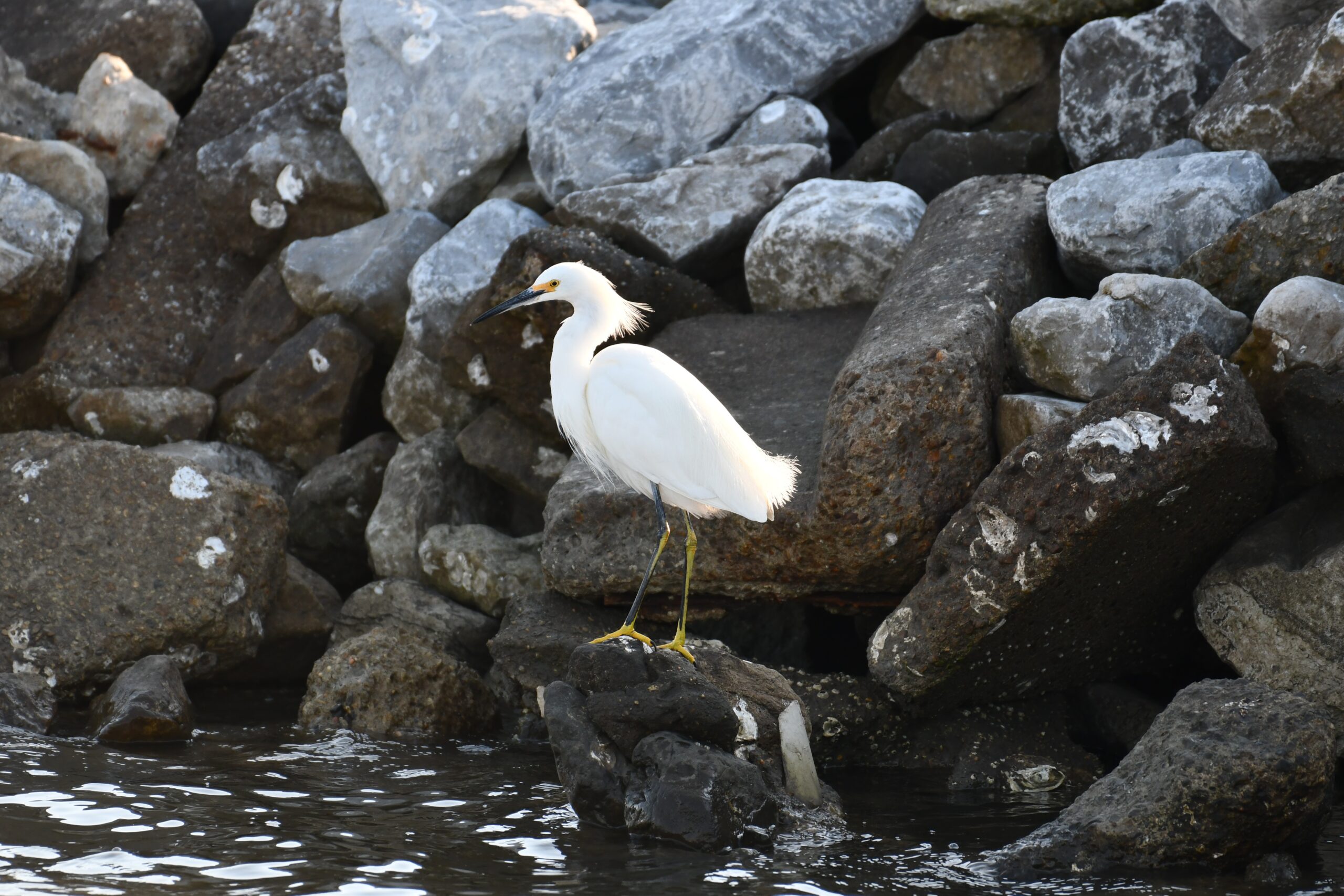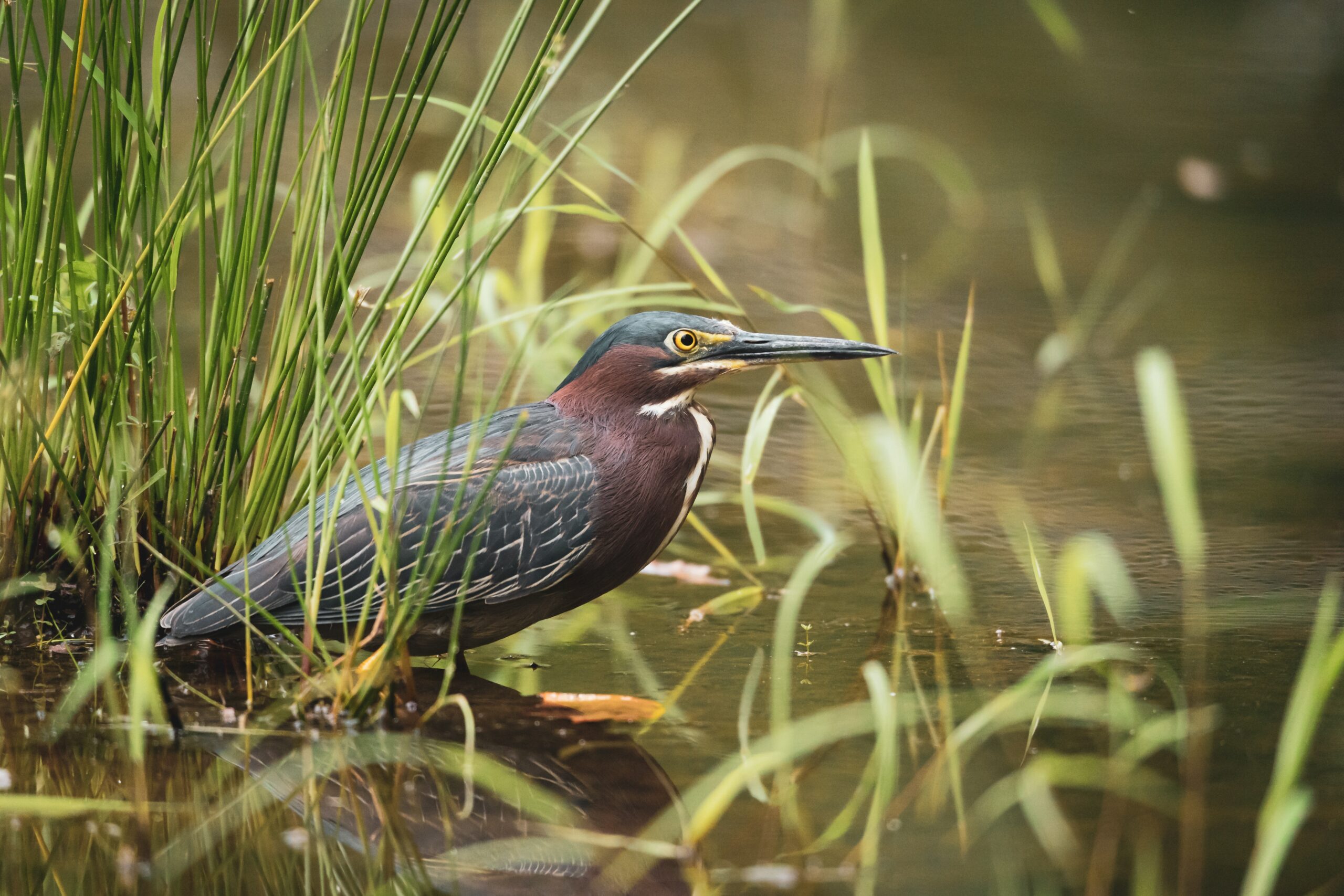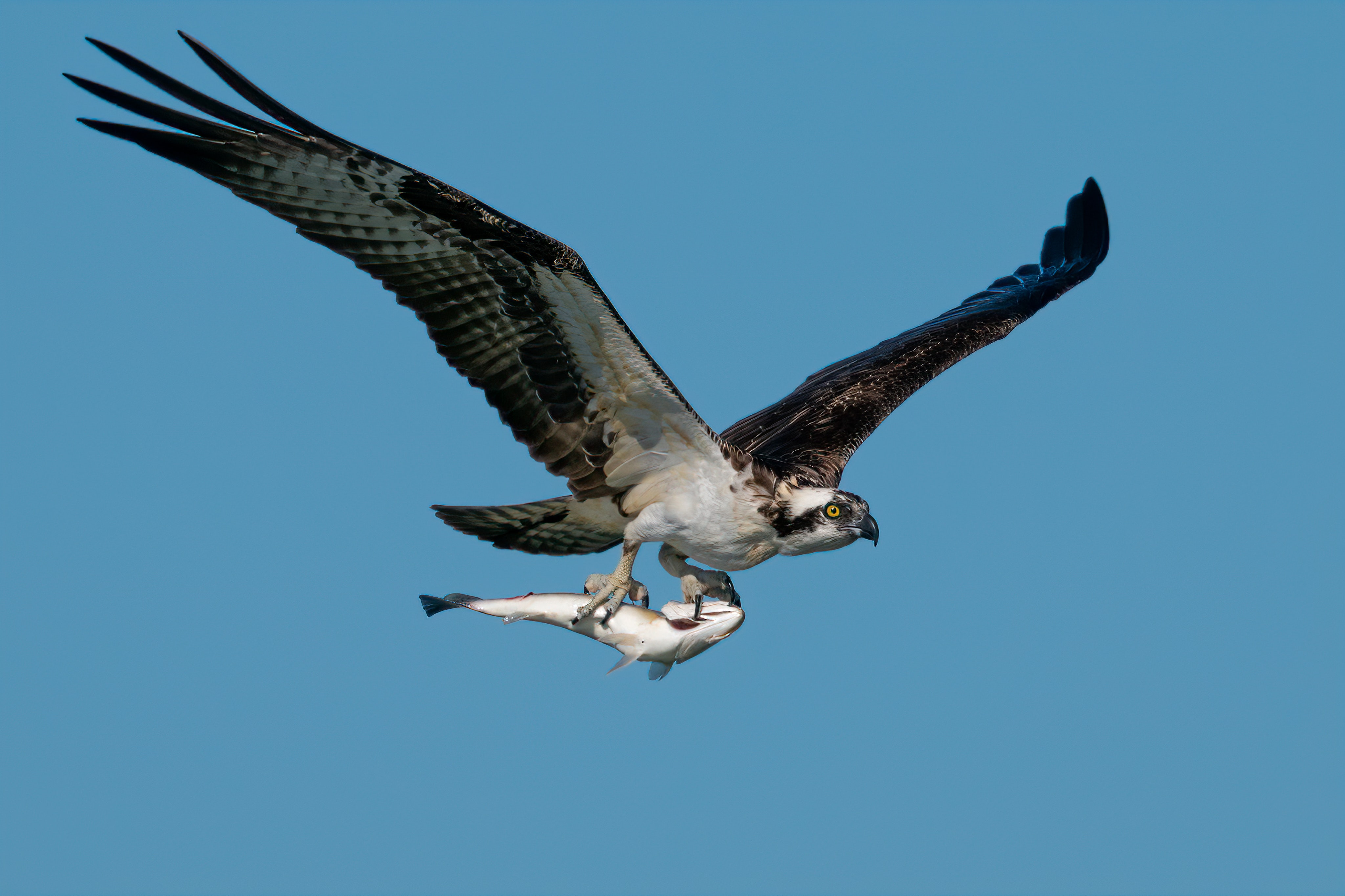
Birds

Lowcountry Birds are special. Our area is home to all kinds of birds including 6 species of herons, several types of egrets, and many others unique to this area.
Great Blue Heron
Ardea herodias
- Identification Information: Blue-grey appearance with a wide black stripe over the eye. Largest of the herons, taller and heavier than a Great Egret.
- Lifespan: Oldest was 24 years and 6 months
- Diet: Great Blue Herons will eat anything in striking distance – fish, amphibians, reptiles, small mammals, insects, and other birds.
- Fun Fact: Great Blue Herons have excellent night vision allowing them to hunt day and night. They may move slowly but can strike with lightning speed to grab a fish. Despite their size, Great Blue Herons only weigh 5-6 pounds because of their hollow bones.
Snowy Egret
Egretta thula
- Identification Information: All white with a black bill, black legs, and yellow feet. Smaller than a Great Egret. During mating season, their feathers stick up like a mohawk to attract a mate. Length: 22-26 inches; Wingspan: 39 inches
- Lifespan: Oldest Snowy Egret was 17 years and 7 months
- Diet: Eat mostly aquatic animals – frogs, fish, worms, crustaceans, and insects. Use their bright yellow feet as a lure.
- Fun Fact: Egrets were on the verge of extinction in the late 19th century because masses were killed for their long breeding plumes (long wispy feathers on their back, neck, and head). Male and female Snowy Egrets take turns incubating their eggs. As one mate takes over for the other, it sometimes presents a stick, as if passing a baton.
Great Egret
Ardea alba
- Identification Information: All feathers are white, yellowish-orange bill, and black legs. Larger than a Snowy Egret but smaller than a Great Blue Heron. Length: 37-40 inches; Wingspan: 51-57 inches.
- Lifespan: Oldest was 22 years and 10 months
- Diet: Small fish, amphibians, reptiles, birds, small mammals, crayfish, shrimp, and insects.
- Fun Fact: The Great Egret is the symbol of the National Audubon Society. During breeding season, a patch of skin on its face turns neon green and long plumes grow from its back. Most hunting is done by wading but occasionally they will swim to capture prey.
Tricolored Heron
Egretta tricolor
- Identification Information: Mix of blue-gray, lavender, and white. Easily distinguished by their white bellies. Medium-sized heron. Length: 23-27 inches; Wingspan: 37 inches.
- Lifespan: Oldest was 17 years and 8 months
- Diet: Feed on small fish. They are skilled at stalking, chasing, and standing & waiting to capture their prey.
- Fun Fact: Once known as Louisiana Herons, Tricolored Herons are commonly found in saltmarshes, especially in Beaufort County.
Yellow-Crowned Night Heron
Nyctanassa violacea
- Identification Information: Adults are cloudy gray birds with a black head, large white cheek patch, and a creamy yellow crown/head plume. Immatures are brown with fine white spots on the back ad wings. Length: 21-27 inches; Wingspan: 22-28 inches
- Lifespan: Oldest was 6 years and 3 months
- Diet: Primarily feed on crabs but also prey on leeches, worms, snails, mussels, insects, frogs, fish, snakes, turtles, young birds, and small mammals.
- Fun Fact: To build their nests, Yellow-Crowned Night Herons usually break dead, brittle twigs and branches directly from standing vegetation. They also sometimes steal twigs from other nests.
Black-Crowned Night Heron
Nycticorax nycticorax
- Identification Information: Adults are light gray with a black back, crown, and bill. Immature Black-Crowned Night Herons are brown with large white spots on the wings and blurry streaks on the underparts. Their bills are yellow and black. Length: 22-26 inches; Wingspan: 45-46 inches.
- Lifespan: Oldest was 21 years and 5 months
- Diet: Leeches, earthworms, insects, crayfish, clams, mussels, fish, amphibians, lizards, snakes, turtles, rodents, birds, and eggs. Rather than stabbing their prey, they grasp it in their bills.
- Fun Fact: They are most active at night or at dusk. Because of their nocturnal behavior, Black-Crowned Night Herons avoid competition with other heron species that use the same habitat during the day.
Brown Pelican
Pelecanus occidentalis
- Identification Information: Gray-brown birds with yellow heads and white necks. During breeding, the back and sides of the neck turn a rich, dark reddish-brown.
- Lifespan: Oldest was 43 years old.
- Diet: Mostly small fish.
- Fun Fact: During a dive (as high as 65 feet), the Brown Pelican tucks its head and rotates its body to the left. This maneuver is to cushion the trachea and esophagus – which are on the right side of the neck – from the impact. It is a myth that pelicans go blind from diving into salt water.
- The American White Pelican, only white pelican in the USA, migrates to the Midwest during warmer months and are occasional visitors to the southeastern coast during the winter.
Green Heron
Butorides virescens
- Identification Information: They are deep green on the back with a chestnut breast and neck. The wings are dark gray. Smallest of our herons, about the size of a crow. Length: 16-18 inches; Wingspan: 25-26 inches.
- Lifespan: Oldest was 7 years and 11 inches.
- Diet: Feed on small fish, insects, spiders, crustaceans, snails, amphibians, reptiles, and rodents.
- Fun Fact: Green Herons are one of the world’s few tool-using bird species. It often creates fishing lures with bread crusts, insects, and feathers, dropping them on the surface of the water to entice small fish. They usually hunt by wading in shallow water, but occasionally dive for deep-water prey.
Bald Eagle
Haliaeetus leucocephalus
- Identification Information: Adults have white heads and tails with dark brown bodies and wings. Their legs and bills are bright yellow. Immature eagles have mostly dark heads and tails. Their brown wings and bodies are mottled. Young birds attain adult plumage in about 5 years. Length: 27-29 inches; Wingspan: 80 inches – greater than a Great Blue Heron!
- Lifespan: Oldest was 38 years.
- Diet: Feed on fish, birds, reptiles, amphibians, crabs, and mammals.
- Fun Fact: The largest Bald Eagle nest on record, in St. Petersburg, FL, was 9.5 feet in diameter, 20 feet deep, and weighed almost 6,000 pounds. In SC, Bald Eagle nest December – March.
Osprey
Pandion haliaetus
- Identification Information: Brown above and white below – overall they are whiter than most raptors. The head is white with a broad brown stripe through the eye. Smaller than a Bald Eagle. Length: 21-22 inches; Wingspan: 59-70 inches.
- Lifespan: Oldest was 25 years and 2 months
- Diet: Eats almost exclusively live fish.
- Fun Fact: Ospreys, also know as seahawks, are excellent anglers. They catch fish on at least 1 in every 4 dives, with success rates sometimes as high as 70%. Osprey have barbed pads on the soles of their feet to help them grip slippery fish.
American OysterCatcher
Haematopus palliatus
- Identification Information: Back and wings are brown, black head and breast, white underparts, yellow eye with a red eye ring, and a bright orange-red bill. Length: 15-17 inches; Wingspan: 14-24 inches.
- Lifespan: Oldest was 23 years and 10 months.
- Diet: Feed mainly on mollusks like oysters, mussels, and clams, but occasionally feed on jellyfish, starfish, sea urchins, shrimp, crabs, and worms.
- Fun Fact: Oystercatchers walk slowly through oyster reefs until they see an oyster that is slightly open, quickly jabbing their bill inside the shell to snip the adductor muscle, which closes the 2 halves of the shell.
Resources
All information found on this page was sourced from The Cornell Lab, All About Birds. Please see the button to the left for more details
Special Shoutout to Jessica Kochman from the Port Royal Sound Foundation! Be sure to check out their website to learn more about their awesome events and activities!












